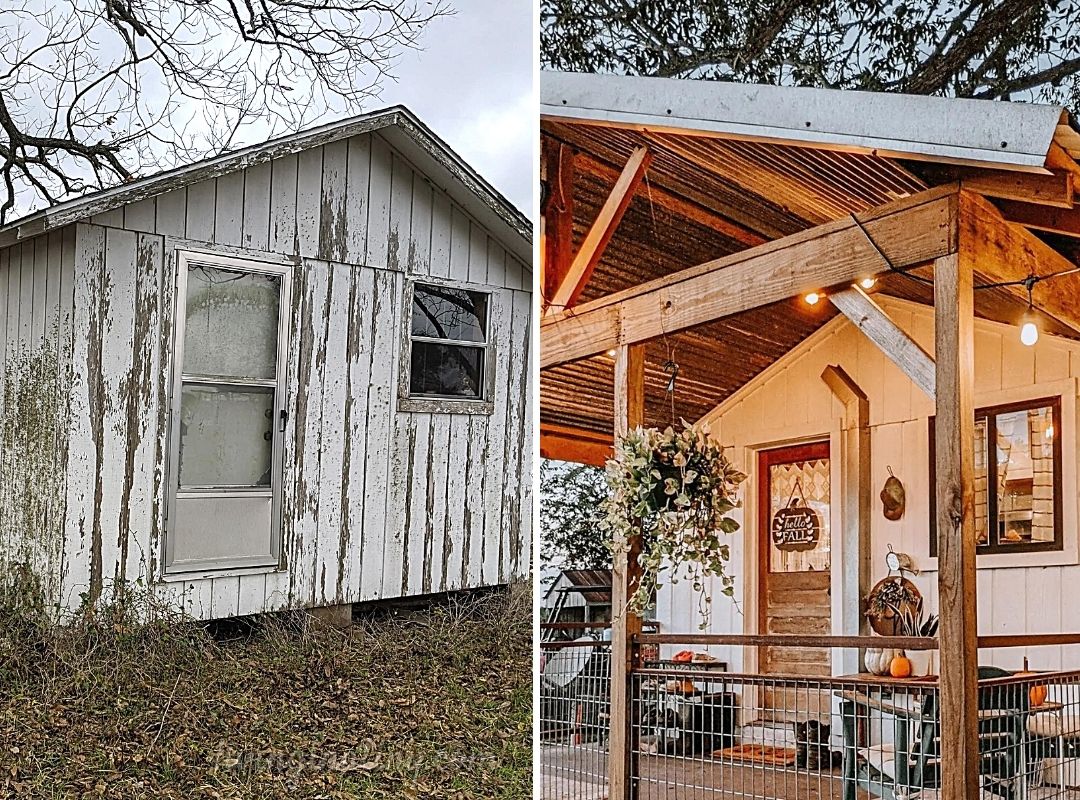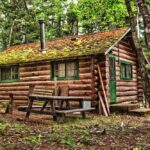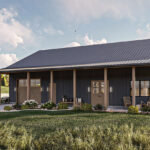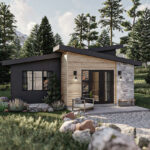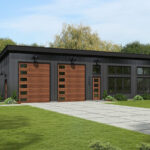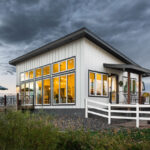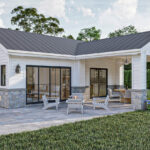Revamping a Shed into a Family Dwelling in Texas
After an old storage shed was inherited, a renovation transformed it into a tiny house. With an investment of approximately $16,000, the new shed became a cozy living space for a family of four. The highlight is a farmhouse-style kitchen, symbolizing the efficient use of space and comfort within this tiny home.
The Journey to a Personal Haven
Katy Krebs and her spouse, Michael, along with their young children, Carolina and Harper, had a realization during the global health crisis: they needed a space to truly call theirs. After years spent in rental living, the charm of homeownership beckoned irresistibly as their family grew.
In Fayetteville, Texas—on a sizable stretch of inherited acreage—sat a humble structure that piqued their interest. This wasn’t just any shed; it held potential for more. With vision and a nod to their future, the couple earmarked the existing shed for transformation.
- Objective: Convert the shed into a cozy, budget-friendly dwelling
- Family Members: A tight-knit family of four
- Reason: Seek stability while saving for a long-term home upgrade
- Location: Inherited land featuring both residential and agricultural zones
This shed, small and worn as it was, would be the foundation of their new chapter. Their plan? To revitalize it into an intimate abode, a stepping stone en route to renovating the property’s main house. Thus, their journey from renters to homeowners began, rooted in family heritage and propelled by aspiration.
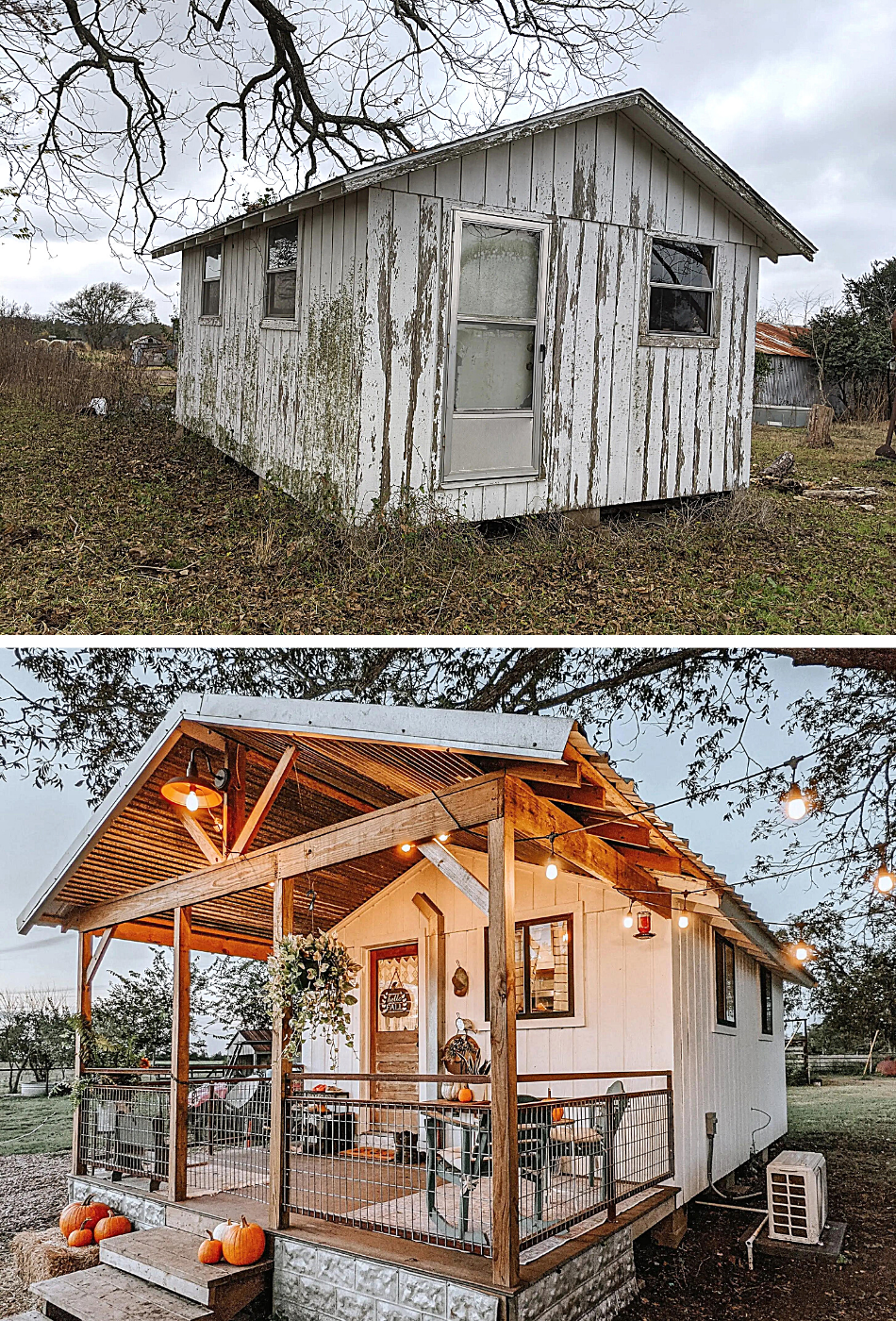
Budget-Conscious Renovation: Embracing the Do-It-Yourself Ethos
In the heart of the renovation, the homeowners embraced the challenge with determination and resourcefulness. They began by stripping the interior to its bones, unveiling insulated walls and a ceiling in unexpectedly good condition, which they wisely chose to preserve. As part of the revamp, they undertook substantial DIY projects, from installing new partition walls to carefully setting in fresh windows, while also giving the roof the attention it needed to ensure resilience.
- DIY Projects:
- Installed partition walls
- Added new windows
- Restored the roof’s integrity
Their cost-effective approach didn’t end there; they retained the original flooring due to its preserved state and carried out repainting, adding a personalized touch to the home. The inclusion of a functional AC system added to the living comfort without breaking the bank.
Enhancement of Light and Air Flow
In the upgrade process, the owners replaced outdated aluminum windows with modern vinyl alternatives, augmenting the structure with two additional windows to bolster both ventilation and natural illumination.
Enhanced Ceilings in Community Spaces
- Living room and kitchen areas: Elevated ceilings
- Addition of ceiling fans to improve airflow
- Skylights installed to maximize natural light
The shed underwent significant renovation, with the introduction of high, sloped ceilings in communal spaces, revealing the structure’s framework and enhancing insulation visibility. Fresh layers of specialized galvanized paint coated the roof to guard against weathering. Walls received a new layer of paint post extensive scraping to remove the worn, weathered layers.
Economical Renovation Through Repurposing Existing Wood
In an effort to conserve funds, the homeowners employed inventive strategies to repurpose wooden materials available on-site. For instance, a substantial beam, initially part of a decaying barn in the surrounding lands, was meticulously restored and installed as a key architectural element. The reclaimed timber from the same barn was seamlessly integrated as paneling for the ceiling, adding a rustic charm to the space. This approach not only preserved the historical essence of the property but also eliminated the need for purchasing new lumber.
- Framing & Flooring: Utilized timber from the property
- Heat Efficiency: Enhanced by the insulation properties of wood
- Interior Aesthetics: Shiplap and plywood from existing materials
- Kitchen Feature: Incorporation of classic elements like a farmhouse sink
The Transformation of a Barn Door into a Home Entrance
When Katy Krebs discovered the barn door, it was in excellent condition. With minimal alterations, involving a thorough sanding and installing a window, the door retained its rustic charm without needing a fresh coat of paint. This upcycled feature became the centerpiece for their tiny house’s façade.
The structure’s original entrance was inconspicuously located at the back. With innovation, they sealed it, crafting a new opening at the front to welcome the repurposed barn door. The result was an inviting porch, adorned with a piece of agricultural history turned into a functional and stylish entryway.
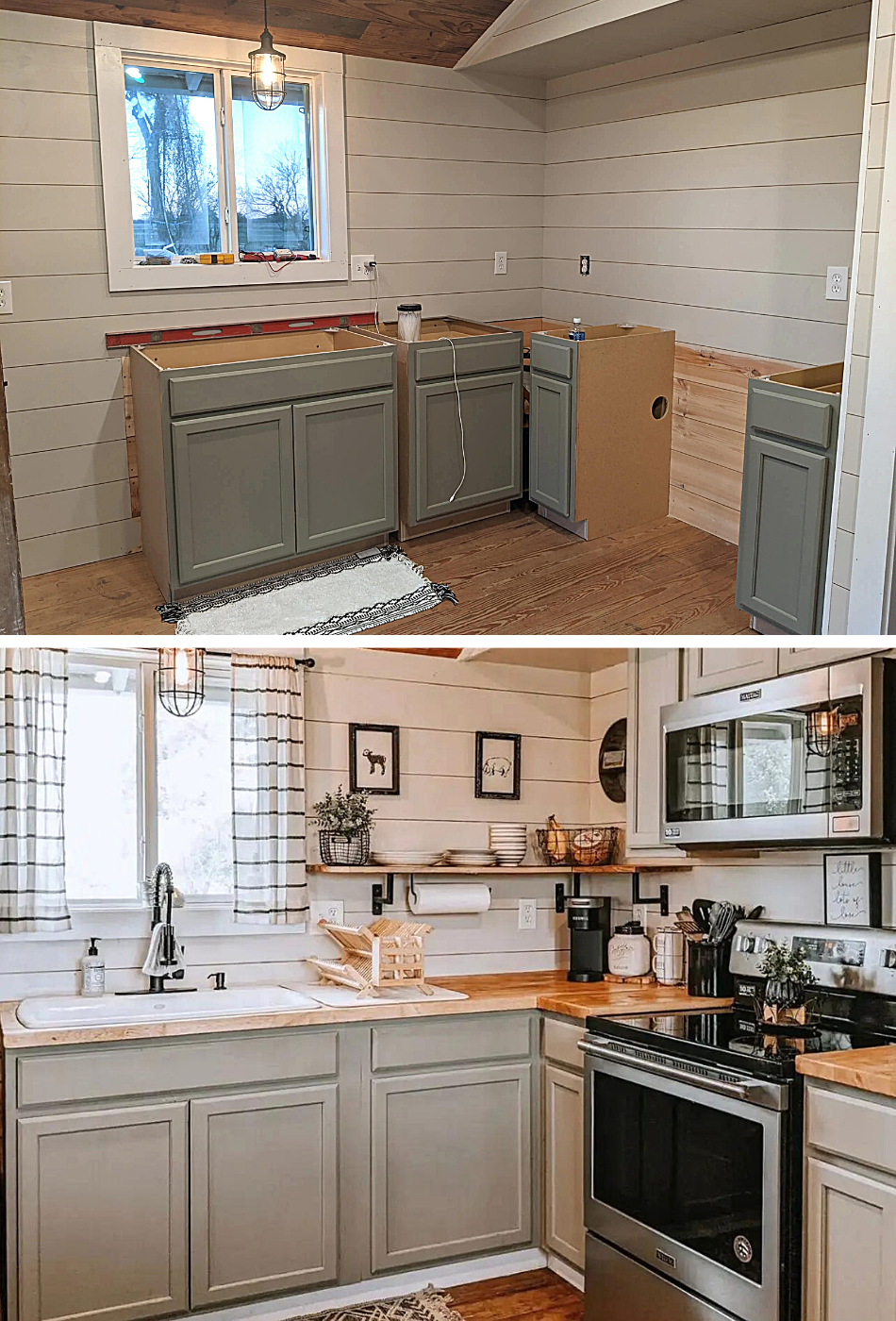
Renovating Challenges: New Wall Construction
The transformation of an expansive space into distinct rooms posed a significant challenge. Katy Krebs and her partner approached this task by first finalizing a layout that converted the undivided area into a practical living space with a bedroom and bathroom alongside the kitchen.
Once the floor plan was set, they embarked on the physical labor. The couple turned to online tutorials to guide them through various stages of the process. With their own hands, and the occasional assistance from their daughters, they erected wooden frames to form the structure of the new walls. Michael’s familiarity with framing proved invaluable, ensuring that they could personally handle the intricacies of constructing stable partitions within their shed-turned-home.
Collective Support in Home Renovation
During the renovation, spanning from September 2020 to May 2021, assistance generously came from relatives and companions. They each contributed uniquely to various elements of the renovation process. It proved to be an engaging project, with the participation and support of their community adding to the collective endeavor.
Self-Sufficiency in Home Wiring
While hiring professionals to connect their tiny home to the primary power grid, the couple undertook much of the electrical wiring themselves. With the plumbing and other systems effectively managed, their personalized touch extends beyond the electricity provisions to installing kitchen cabinets, reflecting their dedication to hands-on involvement in the creation of their new living space.
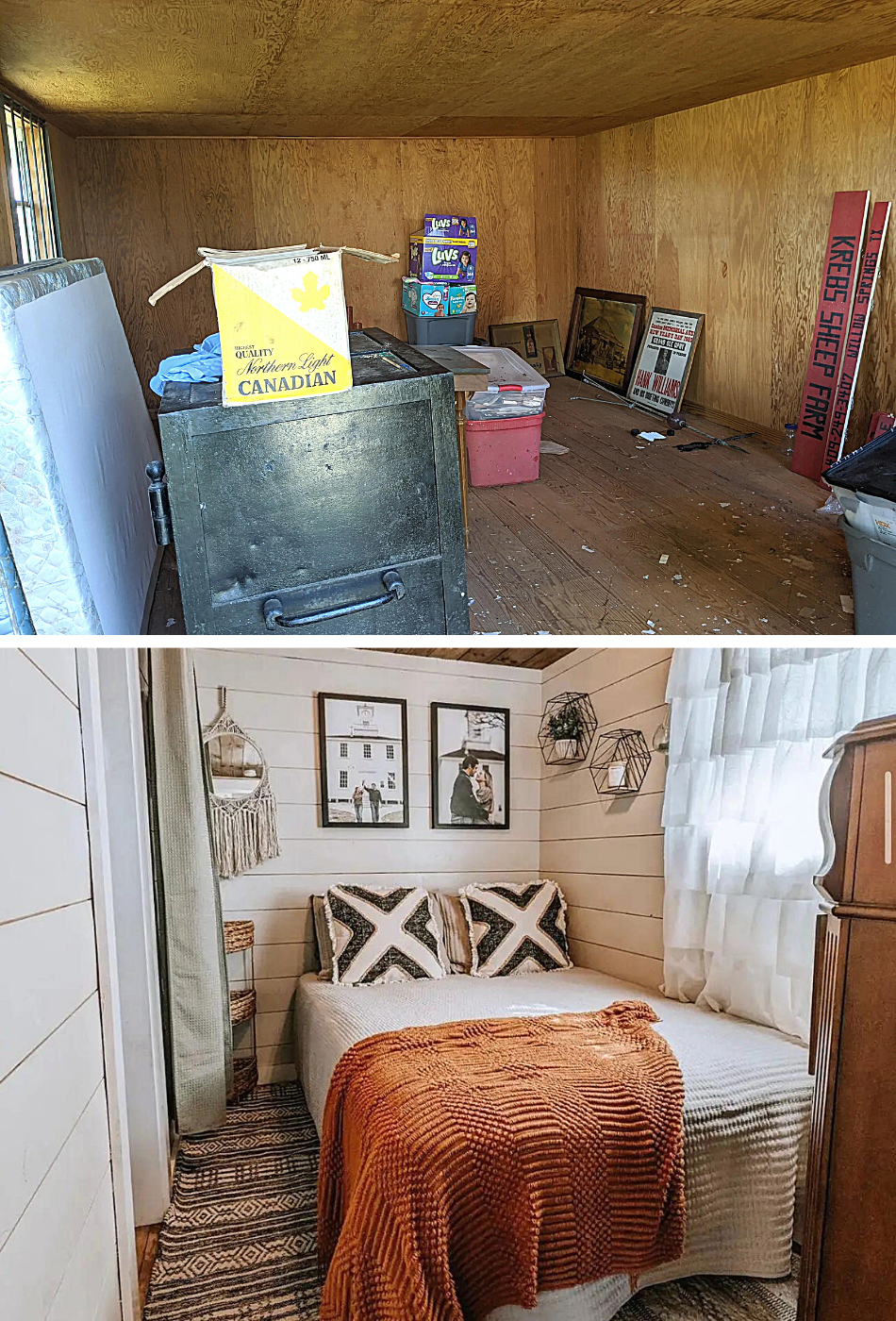
Financial Prudence in Home Renovation
Katy Krebs and her partner succeeded in renovating their residence within the modest sum they allocated for the project. They had targeted to keep their expenses underneath $20,000. Their foresight in financial planning allowed them to complete the work prior to any potential rise in costs due to evolving market circumstances.
Throughout the upgrading process, they encountered no significant delays from supply-chain disruptions, which could be attributed to their strategic reuse of existing materials and their cooperation with a well-stocked local supplier. This approach not only kept them within budget but also mitigated the risks associated with shortages during the pandemic.
| Renovation Aspect | Detail |
|---|---|
| Target Budget | < $20,000 |
| Actual Spending | Approximately $16,000 |
| Material Sourcing | Reused lumber, local store supplies |
| Pandemic Challenges | Minimal impact |
Finished Tiny House Boasts Three Distinct Areas
Upon entering the house, visitors find an open-plan kitchen to the left, complemented by a living area on the right. Separated by a door lies the bedroom, spanning a comfortable 70 square feet, with the bathroom conveniently adjacent.
- Bedroom: Includes storage space and maintains a cozy ambiance.
- Bathroom: Equipped with a shower and essential facilities.
- Living Area: Warmed by efficient heating solutions, with potential for elevated lofts to maximize space.
Flexible Sleeping Arrangements in the Krebs Household
In the Krebs home, the concept of a dedicated bedroom is fluid. Katy Krebs and her daughters often alternate between the main bedroom and a versatile living area space, where a foldable couch doubles as an additional sleeping spot. This arrangement has garnered diverse reactions from social media viewers, some of whom have expressed concern. However, Krebs maintains a pragmatic view, assuring that her children’s safety and comfort are paramount. She emphasizes that their current sleeping situation is a stopgap measure, as plans for individual bedrooms in their future residence are underway.
| Area | Sleeping Options |
|---|---|
| Main Bedroom | Full-sized bed |
| Living Area | Couch that transforms into a bed |
Despite external opinions, Krebs remains assured, looking forward to providing individual rooms for her children in time.
The Highlight of the Home: A Farmhouse-Style Kitchen
Katy Krebs savors the simplicity and charm in her tiny house’s farmhouse-style kitchen. Her vision for a cozy kitchen space came true with the inclusion of a classic farmhouse sink and timeless shiplap walls—an embodiment of how living small can still embrace great taste and comfort.
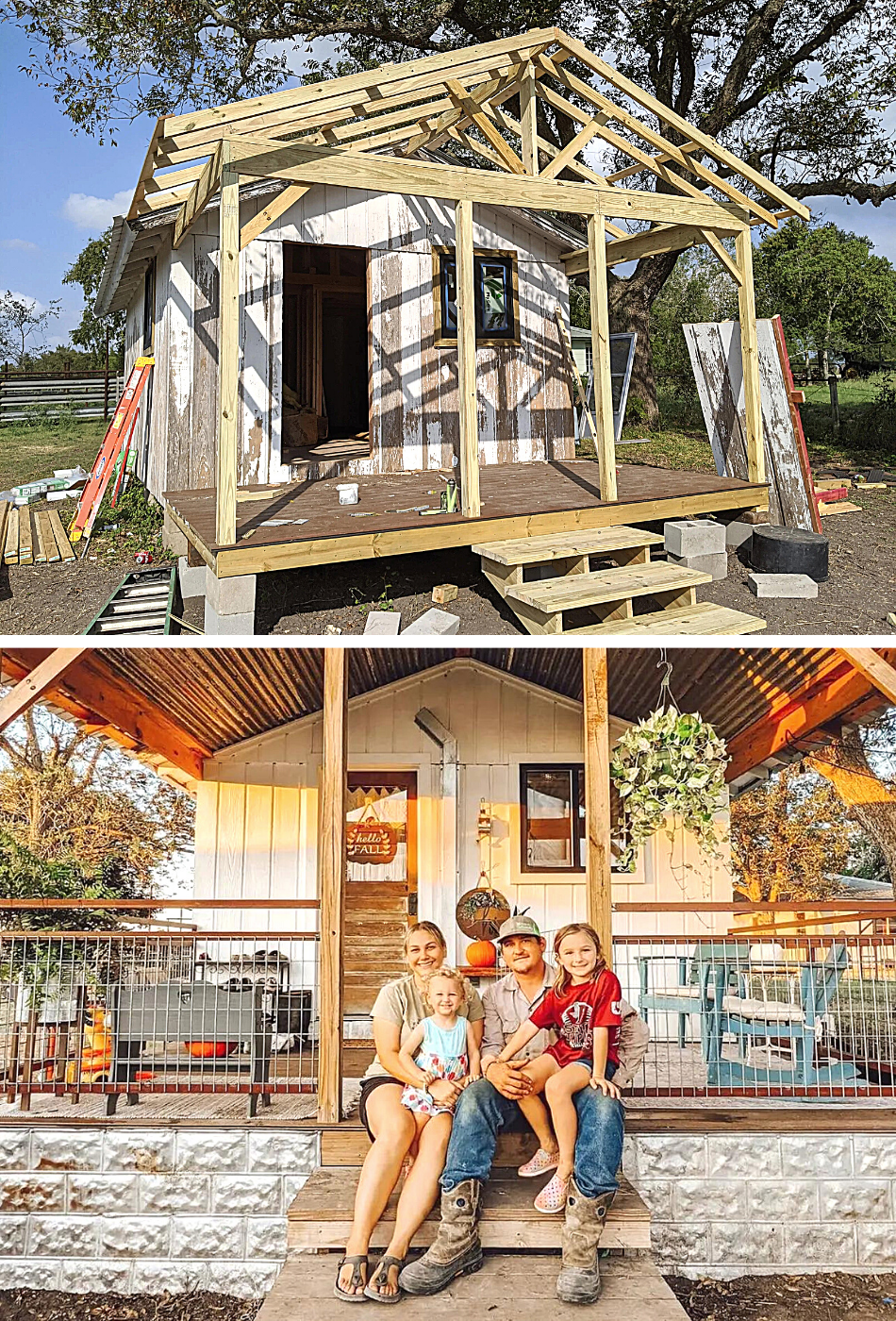
Guidelines for Planning Your Compact Living Space
Katy Krebs suggests a meticulous approach to designing a small residence. Emphasizing the importance of precise planning, she recommends:
- Floor Plans: Draft comprehensive layouts that account for every element.
- To avoid later adjustments, pinpoint positions for:
- Electrical outlets
- Lighting installations
- Major appliances (e.g., air conditioning units)
- To avoid later adjustments, pinpoint positions for:
Krebs’s own experience highlights the value of this step. A last-minute relocation of their AC unit led to unexpected piping across their porch. While initially disruptive to their aesthetic, it serves as a permanent reminder of the significance of thorough pre-construction planning. For additional insights and visual design concepts, exploring YouTube can be beneficial, offering a platform for design inspirations and practical tips from experienced individuals.
A Year of Growth and Discovery for the Krebs Family
After nearly a year in their tiny home, the Krebs family has found deep satisfaction in their simpler lifestyle. The daughters, Carolina and Harper, have embraced the outdoors, trading excessive indoor play for the adventures that await on their doorstep. Surrounded by their own animals, including chickens and cows, the girls flourish in their new environment, nurturing a connection with nature and the freedom it brings.
